David McFall R.A. (1919 - 1988)
Sculptor
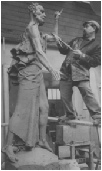
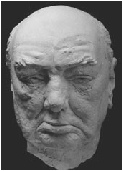
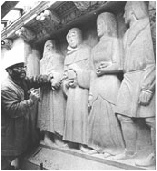
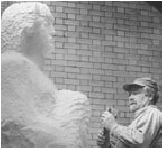

1982/6 Plaque to Hugo Manning Poet
19½" diameter x 2½" thick
At 46 Belsize Square, Hampstead, London
Unveiled 19th September 1982 by Suzan Rappoport & Phil Coram
Hugo Manning, poe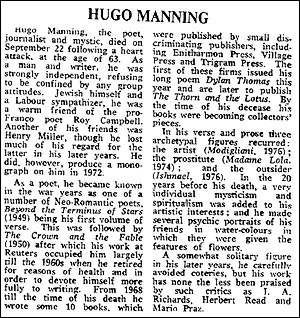 t, journalist, and mystic, has been described as a major poet with
a minor reputation. Born Lazarus Perkoff, als
t, journalist, and mystic, has been described as a major poet with
a minor reputation. Born Lazarus Perkoff, als o known as Hugh Leslie Perkoff, he changed
his name in 1943 to Hugo Manning. Lazarus Perkoff was born on July 15, 1913 at 123
Oxford Street in Mile End Road, London, to Jewish parents, Myer Perkoff, a tailor's
machinist, and Rosa Perkoff (formerly Green), both born in Russian Poland. In time,
Manning's father operated a sweet and tobacco shop in the East End and Manning attended
the Stepney Jewish School until he was 14. Under the name Leslie Perkoff, Manning
studied violin, viola, and theory from 1926 to 1931 at the Trinity College of Music,
London, securing a scholarship in his last three years. In 1929, Manning pursued
his violin study with the renowned European teacher Otakar Sevcik in Pisek, Czechoslovakia.
For unknown reasons, Manning chose not to pursue a career in music; indeed, he appears
to have been reticent about his musical talent, even with his friends. In the early
1930s, Manning (then known as Hugh Leslie Perkoff) returned to London where he wrote
weekly newspaper articles for the Sunday Referee and was a member of its editorial
staff during 1935-36, among other freelance assignments. By May 1937, Manning was
working in Vienna as a correspondent for the Jewish Chronicle and World Film News.
From 1939 to1942, Manning lived in Buenos Aires, Argentina where he was employed
in various capacities by several newspapers and magazines. During his stay in Argentina,
Manning was acquainted with leading South American literary figures such as Victoria
Ocampo, Patricio Gannon with whom he edited the Argentine Anthology of Modern Verse
(1942), and Jorge Luis Borges, who became his lifelong friend. In November 1943,
Manning volunteered for service in the British Army Intelligence Corps. While stationed
in North Africa he suffered a leg injury and was subsequently discharged in August
1944. His injury caused him to walk with a cane for the remainder of his life. In
1946 Manning joined the staff of Reuters, where he served for 19 years on the South
American desk, working nights so he could devote his daytime hours to writing. In
his last few years with Reuters, Manning became the senior sub-editor and features
writer for the UK desk. He retired in 1968 and devoted the remainder of his life
to literary pursuits. Although Manning's career as a journalist began in the early
1930s, it wasn't until 1942 that his verse and prose was published privately and
by small publishers including Villiers, Enitharmon Press, Village Press, and Trigram
Press… A photograph of sculptor David McFall's bust of Manning is also present in
the collection of his papers. After Manning's death, McFall designed a memorial plaque
which was placed at Manning's residence in Belsize Square, London. (University of
Texas at Austin which holds his papers)
o known as Hugh Leslie Perkoff, he changed
his name in 1943 to Hugo Manning. Lazarus Perkoff was born on July 15, 1913 at 123
Oxford Street in Mile End Road, London, to Jewish parents, Myer Perkoff, a tailor's
machinist, and Rosa Perkoff (formerly Green), both born in Russian Poland. In time,
Manning's father operated a sweet and tobacco shop in the East End and Manning attended
the Stepney Jewish School until he was 14. Under the name Leslie Perkoff, Manning
studied violin, viola, and theory from 1926 to 1931 at the Trinity College of Music,
London, securing a scholarship in his last three years. In 1929, Manning pursued
his violin study with the renowned European teacher Otakar Sevcik in Pisek, Czechoslovakia.
For unknown reasons, Manning chose not to pursue a career in music; indeed, he appears
to have been reticent about his musical talent, even with his friends. In the early
1930s, Manning (then known as Hugh Leslie Perkoff) returned to London where he wrote
weekly newspaper articles for the Sunday Referee and was a member of its editorial
staff during 1935-36, among other freelance assignments. By May 1937, Manning was
working in Vienna as a correspondent for the Jewish Chronicle and World Film News.
From 1939 to1942, Manning lived in Buenos Aires, Argentina where he was employed
in various capacities by several newspapers and magazines. During his stay in Argentina,
Manning was acquainted with leading South American literary figures such as Victoria
Ocampo, Patricio Gannon with whom he edited the Argentine Anthology of Modern Verse
(1942), and Jorge Luis Borges, who became his lifelong friend. In November 1943,
Manning volunteered for service in the British Army Intelligence Corps. While stationed
in North Africa he suffered a leg injury and was subsequently discharged in August
1944. His injury caused him to walk with a cane for the remainder of his life. In
1946 Manning joined the staff of Reuters, where he served for 19 years on the South
American desk, working nights so he could devote his daytime hours to writing. In
his last few years with Reuters, Manning became the senior sub-editor and features
writer for the UK desk. He retired in 1968 and devoted the remainder of his life
to literary pursuits. Although Manning's career as a journalist began in the early
1930s, it wasn't until 1942 that his verse and prose was published privately and
by small publishers including Villiers, Enitharmon Press, Village Press, and Trigram
Press… A photograph of sculptor David McFall's bust of Manning is also present in
the collection of his papers. After Manning's death, McFall designed a memorial plaque
which was placed at Manning's residence in Belsize Square, London. (University of
Texas at Austin which holds his papers)
McFall’s sketch of Hugo Manning
All rights reserved

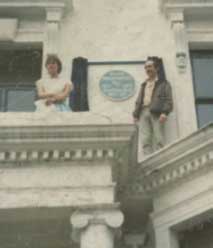

| Animals |
| Busts and Heads |
| Children |
| Churchill studies |
| Lettering |
| Medals coins plates |
| Reliefs |
| Stone carvings |
| Contemporary British Artists |
| On Epstein |
| Picasso |
| The art of portrait sculpture |
| Letters |
| Palliser |
| Son of Man |
| Press |
| Obituaries |
| Memorial address |